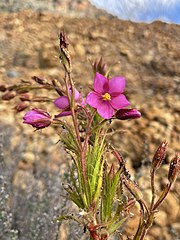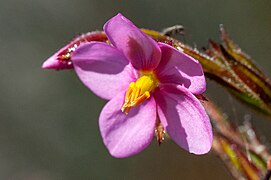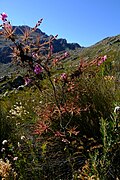| Roridula dentata | |
|---|---|

| |
| Conservation status | |
 Least Concern (SANBI Red List) | |
| Scientific classification | |
| Kingdom: | Plantae |
| Clade: | Tracheophytes |
| Clade: | Angiosperms |
| Clade: | Eudicots |
| Clade: | Asterids |
| Order: | Ericales |
| Family: | Roridulaceae |
| Genus: | Roridula |
| Species: | R. dentata |
| Binomial name | |
| Roridula dentata L. (1764) | |
| Synonyms | |
| |
Roridula dentata (also called the northern dewstick) is a protocarnivorous plant native to the Western Cape province of South Africa.
It can be found only in South Africa, in the hotter and more arid inland mountains of Clanwilliam, Tulbagh and Ceres, and can grow up to more than 150 cm. The leaves are covered with sticky hairs and produce a resin (rather than a mucilage as in most other sticky carnivorous plants), enabling it to catch insects, such as wasps or bees, and very occasionally small birds. It benefits indirectly from catching prey, as several species of Pameridea are unaffected by the stickiness of the leaves. R. dentata then absorbs the nitrogen from the droppings of the insects, resulting in an obligate mutualistic relationship. This relationship is effectively indirect carnivory, which some believe is enough to classify R. dentata as a proper carnivorous plant with flypaper-type traps.
Gallery
-
 Cedarberg dewstick bug on the northern dewstick.
Cedarberg dewstick bug on the northern dewstick.
-
 Close-up
Close-up
-

-

References
- Millington, Andrew; Blumler, Mark; Schickhoff, Udo (2011). The SAGE Handbook of Biogeography. SAGE Publications. pp. 143–. ISBN 978-1-4462-5445-5. Retrieved 2013-08-07.
The Cape Floristic Region in South Africa is comparatively rich in endemic flowering-plant families. Five families of angiosperms (Penaeaceae, Roridulaceae, Geissolomataceae, Grubbiaceae, and Lanariaceae) are endemic to that region ...
- McPherson, Stewart. 2008. Glistening Carnivores: the Sticky-leaved Insect-eating Plants. Poole, Dorset, England: Redfern Natural History Productions. ISBN 978-0-9558918-1-6
- Anderson, B.; Midgley, J.J. (July 2003). "Digestive mutualism, an alternate pathway in plant carnivory". Oikos. 102 (1): 221–224. Bibcode:2003Oikos.102..221A. doi:10.1034/j.1600-0706.2003.12478.x. ISSN 0030-1299.
- Pavlovič, Andrej; Saganová, Michaela (2015-05-06). "A novel insight into the cost–benefit model for the evolution of botanical carnivory". Annals of Botany. 115 (7): 1075–1092. doi:10.1093/aob/mcv050. ISSN 0305-7364. PMC 4648460. PMID 25948113.
| Taxon identifiers | |
|---|---|
| Roridula dentata | |
This Ericales article is a stub. You can help Misplaced Pages by expanding it. |